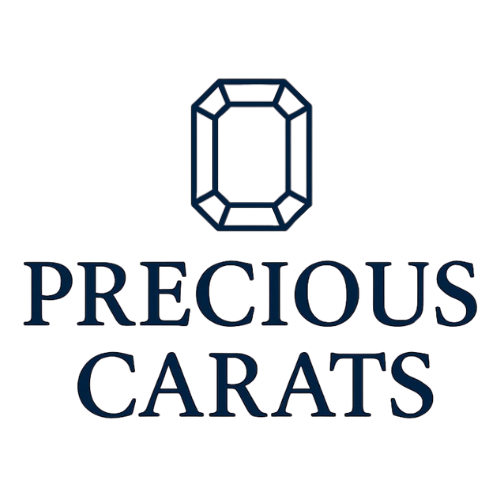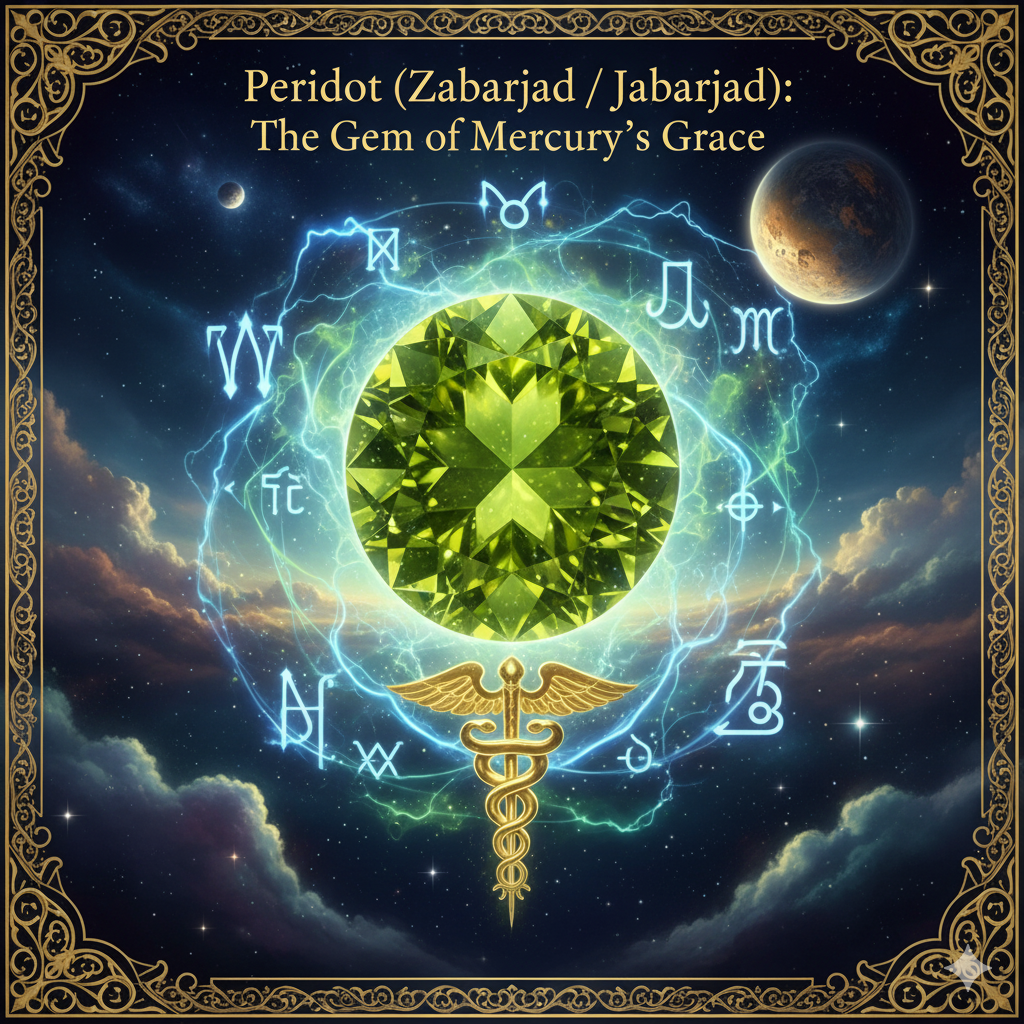Introduction — A Drop of Green Light
Among the gemstones ruled by Mercury, few carry the natural tenderness of Peridot, called Zabarjad in Persian and Jabarjad in Urdu and Arabic. Its luminous green seems to hold sunlight within — warm, pure, and full of understanding.
If Emerald (Panna) is the deep forest, Peridot is the spring leaf.
It whispers of communication, harmony, and renewal — a stone for minds that wish to think clearly and hearts that wish to speak truth.
Names and Cultural Origins
| Name | Region / Language | Meaning |
|---|---|---|
| Peridot | Western gemological term | From faridat meaning “gem” |
| Zabarjad / Jabarjad | Arabic, Persian, Urdu | Traditional term for Peridot |
| Olivine / Chrysolite | Scientific classification | Mineral family of Peridot |
| Budh Ratna | Vedic Astrology | Gem of Mercury (communication, logic) |
Peridot has been cherished since 1500 BCE. Egyptian priests called it “the gem of the sun” and mined it from the volcanic island of Zabargad (St. John’s Island) in the Red Sea.
In Sanskrit texts, it was known as “Budh Ratna”, recommended to those who seek intellect, eloquence, and balanced emotions.
Gemological Profile
| Property | Details |
|---|---|
| Chemical Formula | (Mg, Fe)₂SiO₄ — Magnesium Iron Silicate |
| Crystal System | Orthorhombic |
| Refractive Index | 1.65 – 1.69 |
| Specific Gravity | 3.27 – 3.37 |
| Hardness | 6.5 – 7 (Mohs) |
| Lustre | Vitreous |
| Transparency | Transparent to translucent |
| Typical Colours | Lime green, olive, golden green |
Peridot’s colour is caused by iron within its crystal. Unlike emerald, its hue is always natural — never enhanced by heat or dye — a rarity in the gem world.
Astrological Significance — Gem of Mercury (Budh)
Mercury governs speech, intellect, and adaptability. When afflicted, one may face indecision, miscommunication, or nervous strain.
Wearing Peridot harmonizes Budh’s influence and restores clarity.
Benefits of Wearing Peridot
-
Enhances eloquence and articulation
-
Improves decision-making and analytical ability
-
Strengthens business and negotiation skills
-
Balances emotional overthinking
-
Encourages kindness, forgiveness, and understanding
Planet: Mercury (Budh)
Day: Wednesday
Metal: Silver or Gold
Finger: Little finger of right hand (men) / left hand (women)
Mantra: Om Bum Buddhaya Namah (108 times)
Who Should Wear Zabarjad
-
Students, writers, lawyers, analysts, and teachers
-
Those with weak Mercury in their horoscope
-
Zodiac signs: Gemini (Mithun) and Virgo (Kanya)
-
Anyone who feels anxious in communication or decision-making
Origins and Quality Comparison
1. Pakistani Peridot — The Modern Gold Standard
-
Origin: Suppat and Kohistan regions of Pakistan’s Kashmir belt
-
Colour: Vibrant leaf green with slight golden tone
-
Clarity: Transparent to eye-clean
-
Energy: Bright, fresh, youthful — excellent for astrology
-
Price Range: ₹3,000 – ₹10,000 / ct (fine gem)
Verdict: Best for astrological and collector use; the clearest, most vibrant tone available today.
2. Burmese Peridot — Rich and Velvety
-
Origin: Mogok and Kyaukse regions, Myanmar
-
Colour: Deep olive-green with velvety glow
-
Clarity: Slight silk inclusions; adds character
-
Energy: Mature and grounding
-
Price Range: ₹4,000 – ₹12,000 / ct (premium gem)
Verdict: Favoured by collectors for its luxurious depth and velvety internal glow.
3. Egyptian Zabarjad — Historic but Rare
-
Origin: Zabargad Island, Red Sea
-
Colour: Golden-green, soft luminosity
-
Clarity: Transparent to slightly hazy
-
Energy: Gentle and sacred — historically linked to temple use
-
Price Range: ₹6,000 – ₹15,000 / ct (museum or heirloom grade)
Verdict: Historically revered; modern supply limited, rarely seen in trade.
4. Chinese and African Peridot —
-
Origin: Hainan (China), Tanzania, South Africa
-
Colour: Lighter yellow-green
-
Clarity: Usually included or cloudy, though clean gems also found
-
Energy: Medium
-
Price Range: ₹600 – ₹2,000 / ct
Quick Comparison Table
| Feature | Pakistani | Burmese | Egyptian | African / Chinese |
|---|---|---|---|---|
| Colour Tone | Bright leaf-green | Deep olive | Golden-green | Light green |
| Clarity | High | Medium | Medium-High | Medium |
| Astrological Suitability | ★★★★★ | ★★★★☆ | ★★★★☆ | ★★★★☆ |
| Price (₹/ct) | 3,000 – 10,000 | 4,000 – 12,000 | 6,000 – 15,000 | 600 – 2,000 |
| Availability | Good | Moderate | Rare | Abundant |
Why Zabarjad Is Called “The Evening Emerald”
Under lamplight, Peridot glows even when emerald sleeps. Its slight golden undertone makes it shimmer under warm light, earning it the poetic title “The Evening Emerald.”
In astrology, this symbolizes inner intelligence — shining not in noise, but in subtlety.
Ritual for Wearing Peridot
-
Select: Natural, untreated Peridot (minimum 5 ct)
-
Purify: Dip in Gangajal and raw milk
-
Day & Time: Wednesday morning, Mercury Hora
-
Mantra: Om Bum Buddhaya Namah 108 times
-
Wear On: Little finger, silver or gold ring
Price Guide (India 2025)
| Origin | Grade | Price / ct (₹) | Remarks |
|---|---|---|---|
| Pakistan | Fine–Extra Fine | 3,000 – 10,000 + | Best clarity and tone |
| Burma (Myanmar) | Premium | 4,000 – 12,000 + | Velvety deep tone |
| Egypt (Zabargad) | Collector | 6,000 – 15,000 + | Very rare |
| China / Africa | Commercial | 600 – 2,000 | Budget jewellery |
Colour, clarity, and cut quality determine value. Avoid overly yellow or brownish stones.
How to Identify Real Peridot
Natural Traits:
-
Double refraction visible when viewed through loupe
-
Few needle-like inclusions; oily sheen
-
Warm tone — never neon or artificial
Fake Alerts:
-
Dyed quartz and green glass often sold as Peridot
-
Real Peridot feels heavier and warmer to touch
-
Certificate should read “Natural Olivine (Peridot)” with origin
Emotional & Spiritual Meaning
Peridot’s gentle frequency soothes anxiety and promotes forgiveness. It clears jealousy and resentment — traits Mercury purifies when strong.
Many wearers describe feeling “mentally lighter” within a week of wearing it.
It’s also associated with the Heart Chakra (Anahata), restoring emotional openness and empathy.
Jewellery & Design
-
Classic: Oval cabochon rings in silver
-
Modern: Step-cut rectangular pendants with gold bezels
-
Heritage: Multi-stone bracelets pairing Peridot with Pearl or Citrine
-
Luxury: Burmese Peridot set in rose gold for warm contrast
At PreciousCarats, every Zabarjad is photographed under daylight to reflect its true hue — no artificial saturation, no haste. Each gem is accompanied by an independent certificate of authenticity.
Care & Maintenance
-
Clean gently with mild soap and soft cloth
-
Avoid ultrasonic cleaners or sudden temperature changes
-
Store separately to prevent scratches from harder gems
Peridot’s radiance deepens with care — its glow maturing softly over years, like polished sunlight.
FAQs
Q1. Is Peridot a substitute for Emerald (Panna)?
Yes. It’s the official upratna (secondary gem) for Mercury, offering similar benefits with a gentler vibration.
Q2. Which origin is best for astrology?
Pakistani and Burmese Peridots are considered the most effective due to their clarity and balanced hue.
Q3. Can I wear Peridot and Emerald together?
Yes, when Mercury is favourable; it amplifies Budh’s positive traits.
Q4. What is the best carat weight for Peridot?
At least 5 carats for visible astrological impact.
Q5. Can Peridot change colour?
Natural stones remain stable; only heat or chemicals can dull them.
Conclusion — Light, Logic, and Grace
Peridot, or Zabarjad, is more than a green gem. It is Mercury’s quiet blessing — a balance between intellect and empathy.
While Emerald speaks with prestige, Peridot listens with warmth.
Born in volcanic fire yet cooling to the touch, it embodies harmony: between mind and heart, ambition and humility, reason and kindness.
For those who think too much, feel too deeply, or speak too little — Zabarjad offers one message in its tranquil glow: clarity is compassion made visible.

